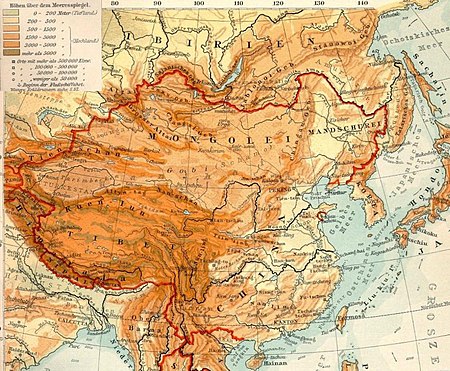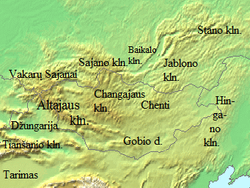Mongolian plateau
The Mongolian Plateau is one of the largest plateaus in Asia, which includes the Gobi Desert and the surrounding highland steppes . It lies on the territory of Mongolia and northern China and is the largest high plateau in Central and East Asia after the Tibetan highlands . In contrast to Tibet, however, it only has an average altitude of 900 to about 1500 meters. The mountains surrounding the large plateau are 3 to 5000 m high.
The plateau extends over an approximately rectangular area of over 2,000 × 1,000 km from the Tianschan Mountains of Central Asia to the mountain ranges of the Great Hinggan Mountains in northeast Inner Mongolia . In the south it is bounded by the Nan Shan Mountains and the Ordos Plateau on the Yellow River . In the southeast, its foothills reach up to about 200 km from Beijing and were fortified in the past by the " Great Wall ". In the north, the plateau is bounded by the Mongolian high mountains ( Altai and Changai Mountains ) and the mountainous region south of Lake Baikal .
The elongated, undulating plateau has a very dry climate and the character of deserts and steppes ; the few bodies of water are almost without exception inland rivers that dry up in the lower reaches. Occasionally the plateau turns into mountainous country, but is traversed in its geographical center by the mountain ranges of the Gobi-Altai (peaks up to 2,800 m). In eastern Mongolia , the plateau has formed numerous salt marshes , some of which drain over the Cherlen River to the Amur . The southeast, the Inner Mongolia Plateau , lies on the territory of China and partly drains to the Yellow Sea.

